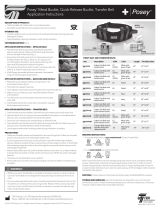Page is loading ...

OptoGait User Guide
Installation and Use

Contents
Necessary Equipment…………………………………………………………….1
Initial Installation.……………………………………….…...........………........….2
Utilising the OptoGait Software……….……….…….……………....…….3 - 28
Camera Setup ….…………………….…………….………..…….3 - 4
Hardware Test …………………………………….….…………….5 - 6
Additional Devices ……………………….…………...….…........7 - 8
Creating a Patient ………………………………….……..…….9 - 10
Setting Up a Test………………………………….…….............11 - 14
Running a Test…………………………….…….…….…………15 - 18
Managing Data……………………………….……..………….19 - 22
Using Biofeedback Mode ………………….……..................23 - 25
Support from GMF and Help Functions………………….…26 – 27
Further Technical Support…………………………….…………….28

1
Necessary Equipment
The equipment needed for a standard OptoGait set-up includes the following:
The following cables are also required to operate the OptoGait system:
Lemo cable (small silver cable with red dot, x1). Optional – used In combination with EMG.
Power cables for charging the TX and RX bars (x2).
USB cable
Laptop charging cable for extensive data collection sessions.
Transmitting (labelled TX) Bar Receiving (labelled RX) Bar
Logitech Camera with Tripod (x2)
Laptop/Computer with OptoGait Software Installed

2
Initial Installation
The RX and TX bars should be placed on either side of a treadmill or in a large, open floorspace with the LED
strips facing each other. When setting up a treadmill gait test, the interface sides of the bars should be placed
at the front of the treadmill.
1) After placing the TX and RX Bars in the correct position, plug in the power cables for each bar. When an
OptoGait system is being used for the first time, the RX and TX bars may need to be charged prior to use.
2) The Lemo (if EMG is in use) and USB cables are plugged into the RX bars and then directly into the lap
top/computer via a USB port. Please note: A standard OptoGait set-up requires three computer USB port
to connect the RX bar cables and Logitech Cameras.
3) The Cameras should be placed on a side and rear view (see Necessary Equipment for reference). When
using the OptoGait system for research purposes, a frontal view camera may be adopted.
4) The OptoGait system can be switched on using the power switches, located on the interface side of both
the TX and RX bars.
5) Initially, a red LED light will appear and then change to green after 2-3 seconds to show that the TX and
RX bars are connected to each other. In the case that no green
LED light appears, make sure that the
bars are parallel to each other and that no external objects are obstructing the floor space/treadmill belt.
6) After the RX and TX bars are connected to each other, switch on the computer/laptop and open up the
OptoGait software. The OptoGait loading screen then appear and typically take 1 – 2 minutes to load.
Interface Side of Bars
LED strips

3
Utilising the Optogait Software
Camera Setup
1) To select the cameras currently plugged into the laptop/computer, click on ‘Utilities’ in the top right-hand
corner.
2) Go to the ‘Video’ section and select Video 1 and Video 2, for example Logitech Pro Webcam C920,
Logitech Pro Webcam C920 #2.
3) Click on ‘Test’ and select the gain and exposure of each camera. Clicking on the ‘Auto’ tick box for both
gain and exposure will produce the optimum image quality.

4
4) Click on ‘Advanced’ to select the camera zoom, contrast, brightness, saturation, sharpness and focus.
This section allows the user to select the optimum image quality for all aspects of the video image.
5) To finalise any changes made to video 1 and/or 2, select ‘Confirm’.

5
Hardware Test
1) To perform a OptoGait hardware test, click on ‘Utilities’ in the top right-hand corner.
2) Click on ‘OptoGait hw Test’
3) To execute a hardware test, select ‘Execute’.

6
4) After selecting ‘Execute’, the software will perform a standard hardware test. Any interferences between
the LED’s will appear in red on the diagram below the video image. If there are no interferences between
the LED’s, then testing can begin.
5) If there are any issues relating to the LED’s, Click ‘Hardware Reset’

7
Additional Devices
To use the OptoGait in combination with another device, for example Gyko or EMG, click on
‘Utilities’.
1) Click on ‘Basic Settings’.
2) Click on ‘Devices’.
3) Having followed the instructions for the device, click on ‘New Search’ to see all the available
devices. If the additional device has been connected correctly, the device will appear in the
‘Available Devices’ section.
4) After selecting the device, click on the specific device and select ‘Activate’. The selected
device will then appear in the ‘Active Device’ section.
5) After the device appears in the ‘Available Devices’ section, click ‘Update’ to confirm the device
selection.
6) Devices can also be removed by clicking ‘Remove’.

8

9
Creating a Patient
1) To create a patient, click on ‘Patients’ tab in the top left-hand corner.
2) Click on ‘Insert/Modify Patient’.
3) To create a new patient, click on ‘New Patient’ in the top right-hand corner. On this page the
patients name, date of birth, height, weight, gender, an image for reference purposes and other
information can be added.
4) The patients foot size can then be measured by clicking ‘Acquire Foot Size’. A pop-up will then
appear that reads ‘Acquiring Foot Size’. At this stage, the patient should be instructed to stand
between the TX and RX bars and their foot size will be subsequently measured.

10
5) After inputting any necessary details, the three ways to save the patient’s profile (all located in
the top right-hand corner) includes:
‐ ‘Save’ – Save and go back to the OptoGait home screen.
‐ ‘Save and New’ – Save and create a further new patient.
‐ ‘Save and Execute’ – Save and begin a patient test.

11
Setting Up a Test
1) To execute a test, click on the ‘Test’ tab on the top tool bar.
2) To execute a test directly, click on ‘Execute’. This will then allow the clinician to select the
patient, as well as the type of exercise and protocol they wish to run.
3) To create a test, click on ‘Define/Modify Tests’.
4) Click on ‘New Test’.
5) Input the test details including the patients name, test type, start type, starting foot, end type,
test duration, treadmill speed and any notes that may be specific to the test.
6) Click ‘Save’.

12
7) Tests can be modified by clicking on ‘Edit Test’, ‘Duplicate Test’ or transferred by clicking on
‘Export Test’ or ‘Import Test’.
8) An existing test, for example Treadmill Walking 3MPH or 5KP/H, can be selected from the scroll
down list labelled ‘Test’.
9) To create or edit a test, click on ‘Define/Modify Protocols’.

13
10) Click ‘New Protocol’.
11) After clicking ‘New Protocol’, Select the protocol(s) and click on the sideward arrow to move
them to the section labelled ‘Protocol’.
12) Click ‘Save’.
13) Protocols can be modified or deleted by clicking on ‘Edit Protocol’ or ‘Delete Protocol’.

14
14) An existing protocol (Body Sway Protocol, Single Leg 3 Hops 2D Protocol etc.) can be selected
from the scroll down list labelled ‘Protocol’.

15
Running a Test
1) After clicking on ‘Execute’, select the patient, test and protocol.
2) If the software visuals need to be altered, click on ‘Configuration’ and choose to either show or
hide charts, display video and quantitative data, and alter the overall execution of the test.
3) To start the test, click ‘Execute’.

16
4) A pop-up will appear highlighting the direction of the treadmill belt and selected speed. After
selecting the speed on the OptoGait software, set the same speed on the treadmill.
5) To start the test, click ‘Start’.

17
6) The test will start after selecting the starting foot. After clicking on the left or right foot icon, data
collection will begin.
7) If the test is being stopped by a ‘Software Command’ (manually), click ‘Stop’ to finish the test.
Otherwise, if the test is being stopped by ‘End of Time’, wait for the time to run out.

18
8) During the test, real-time data (including standard deviations) will be collected within the ‘Gait
Report’ section of the testing screen. This screen will also display video footage from both
cameras and a pie chart demonstrating the time that the patient spent within pre-selected
thresholds for the variable of choice, for example the figure below shows that the patient spent
11% of a 1-minute treadmill gait test in the ‘good’ (green) threshold for Stance Phase.
9) After the test has finished, click ‘Save’ to save the test data.
/





